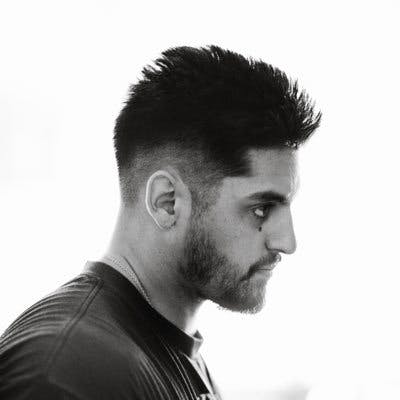Building Your Personal Brand On Twitter
Building a personal brand comes down to a three-part loop.
Where your content types form your identity.
How it’s delivered creates an emotional attachment.
And consistently delivering that value forms the expectation.
This, over a period of time, creates your reputation.
That’s your personal brand.
Let’s break it down piece by piece.
Forming Your Anchor Point
I deeply believe when someone first sets off to start building their personal brand, it’s essential to establish what identity you want to build.
And you can define that identity as what people know you for.
Meaning what you create content around.
Because your identity will serve as a magnet for the people you want to attract.
And in a noisy world, your identity is your anchor point.
It’s not only what attracts people to you, but it’s why they will engage with you.
And you see it constantly on Twitter — people try to build large followings without considering the topics they cover in their content.
Therefore, they never establish an anchor point, and instead, their audience is broken into many different segments.
This engagement tends to minimize overtime.
When you look at some of the best creators on the platform, they’ve engrained their identity into their audience.

Examples:
Anthony Pompliano - Forms his identity around Bitcoin.
David Perrell - Forms his identity around writing, business, and life.
Codie Sanchez - Forms her identity around boring, cash-flow businesses.
Nik Sharma - Forms his identity around Direct-To-Consumer brands and marketing.
Ryan Holiday - Forms his identity around Stoicism.
Trung Phan - Forms his identity around memes and breakdowns.
And when you match your identity with your content, then growth is a side effect and not a goal.
Here’s how Codie Sanchez matches her identity to her content:

And here’s the side effect:
Over 100K+ followers in a year.

So, the way I like to think of my identity is if someone didn’t know my name and were in conversation, would they be able to pinpoint what I talk about because of the content I publish?
I don’t consume all of Codie Sanchez’s content, but I know that she’s an advocate for boring cash-flow businesses.
Again, I don’t consume all of David Perrell’s content, but I know he’s a writer sharing how to excel at writing.
This reputation forms your identity.
Content Types
Building a personal brand is different than building a business account. Because of this, the content focus should shift too.
And after growing my account and talking to individuals who grew both their personal accounts and brand accounts, there are overlaps — but also content types where an individual should focus.
These content types offer the biggest bang for your buck to grow and cement your identity.
1. Threads

Have a lot to say; distill it into a Twitter thread that's primed for success.
Twitter threads are what I call "Growth Content." Meaning it's the form of content that the algorithm prefers, resulting in damn near endless reach.
2. Memes

Memes transcend among all social platforms. And that's one of the factors that makes them effective for personal branding.
They seamlessly inject themselves into culture while spreading like wildfire because they're one of the most effective ways to communicate in today’s digital world.
3. Quick Tips

Take learnings and distill them into quick, short, but valuable tips. Quick value adds compound over time.
4. Video

Video isn't native to Twitter. But there are always exceptions to the rule -- and that's creating video content around trending searches, headlines, and stories.
5. Sh*t Posting

Sh*t posting is like comedy. It pushes the boundaries and attracts people who share similar humor relevant to their craft.
6. Build In Public

Share your journey to attract people on a similar journey and solidify the "buy-in" from your audience.
7. Digital Blogs

The alternative to the Thread route is sharing digital blog posts. The principles are the same.
Hook them with your copy and real them in with your content.
8. Curation

Not every piece of content needs to be original.
There is interesting information all around us; curate your favorites relevant to your identity.
9. Visuals

Two ways to skin the cat here.
If you can visually explain something better than you can write it — show it.
Take large pieces of content and break them into digestible chunks.
Maximizing How You Deliver Your Content
After determining your content types, we want to determine what bucket the content types fall into.
This will determine if your content is valuable.
While value is subjective, I define value as exchanging time for micro pleasure.
Meaning, if an individual gives me their time, then, in return, I will provide them with either education, inspiration, or entertainment.
Those value exchanges compound and over time, develop your personal brand.
So, here are examples of tweets that went viral and the buckets they fall into:
1. Education

Grap a topic or learning and dissect it into a digestible piece of content.
2. Inspiration

Tell a story that inspires or shares information that drives people to take action.
3. Entertainment

Make someone happy, laugh, cry, or all in one.
To make sure you're creating one of three, run your content through the bucket test to determine its value.
And then pass your content through the “so-what” test?
The “So-What” test makes you analyze your content and understand why it’s important to your audience.
If you can’t define its importance, your audience won’t either.
The Emotion Checklist
After your content passes the bucket test, it needs to check the emotional checklist.
The emotional checklist helps maximize your content for shareability.
It’s simple, people share what makes them feel some kind of way.
Your content has to strike some form of emotion in the individual to do this.
Because value + emotion = virality.
Emotions are tools at your disposal, ready to be used.
Because with them, you’re not only transferring emotion but also energy.
Here are the basic forms of emotions:

List the emotion you want your content to spark, and write until you can feel your words bring it to life.
Utilizing Twitter’s SEO
Twitter’s Topics is a feature that allows you to select topics that you're interested in and then displays content relevant to that topic on your feed, even if you don’t follow that person. This means you’re exposed to new individuals every day.
Just like Google, this works based on keywords. But unlike Google, the trending content in those topics changes on a daily basis.
So your content can trend one day and not the next. But think of Twitter topics as a page on Google that rotates daily.
If you can make it on page one, you’re going to consistently expose yourself to a new group of people every time.
How To Consistently Trend In A Topic
I use three steps to maximize my chances of trending in a topic.
1. Keywords
- Using the keywords relevant to the topic will increase your chances of trending in that topic. For example, if you want to trend in “Startups,” then using the word “Startup” in your tweet will increase your chances of trending. You can also use words and phrases relevant to the topic to trend.
2. Content Patterns
- There are formats for tweets that perform better than others. Study the creators who consistently trend in specific topics and steal how they structure and frame their tweets for maximum engagement.
3. Engage With Topic Trenders
- Twiter’s algorithm recommends people to follow based on the content and communities you’re a part of. So the more you engage in certain communities (think of the people who follow a topic as a community), the more you will become a suggested follow to others in that community.
To maximize this, I would pick five topics and create content daily for those topics.
I would center that content around three questions:
- What do I want to be known for?
- How can I provide insight or value to this topic?
- Which topics have the highest correlation to my craft/products?
The Starting Grounds For Your Content Ideas
Generating ideas is no easy feat.
But the good part is, ideas are all around us waiting to be packaged as content.
Here’s a list of my favorite ways to generate ideas to plug into my content types:
1. Go through your DMs
- Find repeated questions in your DMs and use them as your content base.
2. Share Personal Experiences
- List a set of accomplishments and break down the process behind them.
- You can create both long-form and short-term content from this.
3. Answer The Public
- Enter different topics into “Answer The Public” and generate a list of ideas based on Google searches.
4. Use Twitter's Advanced Search To Find Hidden Gems
- Plug this into Twitter but replace "Startups" with whatever topic you want to explore. Example: startups min_retweets:300


